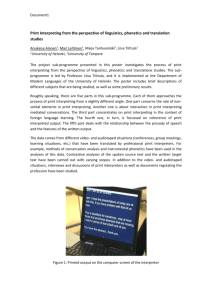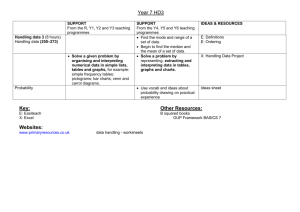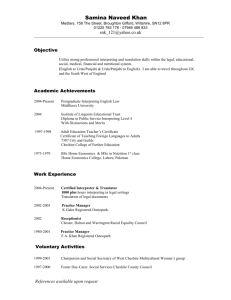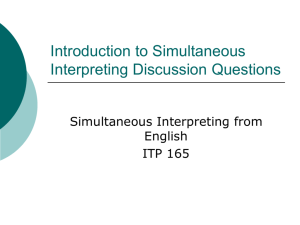EI202 - Mohawk Valley Community College
advertisement
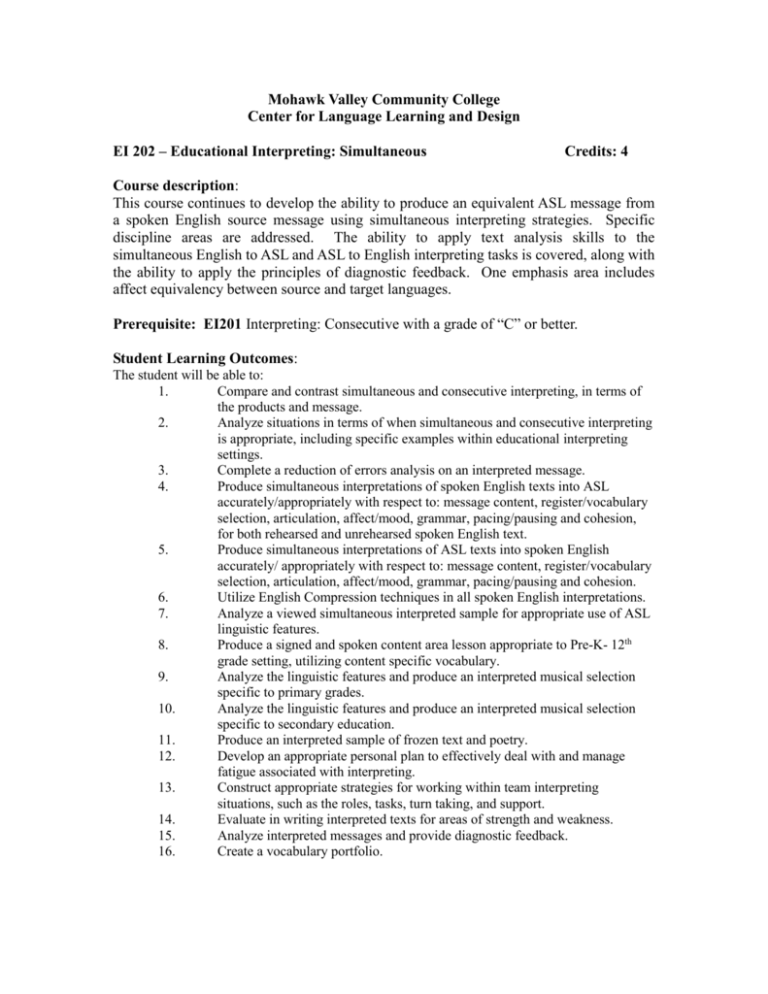
Mohawk Valley Community College Center for Language Learning and Design EI 202 – Educational Interpreting: Simultaneous Credits: 4 Course description: This course continues to develop the ability to produce an equivalent ASL message from a spoken English source message using simultaneous interpreting strategies. Specific discipline areas are addressed. The ability to apply text analysis skills to the simultaneous English to ASL and ASL to English interpreting tasks is covered, along with the ability to apply the principles of diagnostic feedback. One emphasis area includes affect equivalency between source and target languages. Prerequisite: EI201 Interpreting: Consecutive with a grade of “C” or better. Student Learning Outcomes: The student will be able to: 1. Compare and contrast simultaneous and consecutive interpreting, in terms of the products and message. 2. Analyze situations in terms of when simultaneous and consecutive interpreting is appropriate, including specific examples within educational interpreting settings. 3. Complete a reduction of errors analysis on an interpreted message. 4. Produce simultaneous interpretations of spoken English texts into ASL accurately/appropriately with respect to: message content, register/vocabulary selection, articulation, affect/mood, grammar, pacing/pausing and cohesion, for both rehearsed and unrehearsed spoken English text. 5. Produce simultaneous interpretations of ASL texts into spoken English accurately/ appropriately with respect to: message content, register/vocabulary selection, articulation, affect/mood, grammar, pacing/pausing and cohesion. 6. Utilize English Compression techniques in all spoken English interpretations. 7. Analyze a viewed simultaneous interpreted sample for appropriate use of ASL linguistic features. 8. Produce a signed and spoken content area lesson appropriate to Pre-K- 12th grade setting, utilizing content specific vocabulary. 9. Analyze the linguistic features and produce an interpreted musical selection specific to primary grades. 10. Analyze the linguistic features and produce an interpreted musical selection specific to secondary education. 11. Produce an interpreted sample of frozen text and poetry. 12. Develop an appropriate personal plan to effectively deal with and manage fatigue associated with interpreting. 13. Construct appropriate strategies for working within team interpreting situations, such as the roles, tasks, turn taking, and support. 14. Evaluate in writing interpreted texts for areas of strength and weakness. 15. Analyze interpreted messages and provide diagnostic feedback. 16. Create a vocabulary portfolio. 17. Demonstrate appropriate simultaneous interpreting strategies for diverse populations, including individuals with Cochlear implants, individuals who are Deaf/Blind and individuals with multiple disabilities. Major Topics: Introduction to the Simultaneous Mode of Interpreting Comparing Simultaneous Interpreting with Consecutive: Process, Settings and Consumer groups Identifying each singular task involved in the interpretation process Developing Skill Sets required for effective working interpreters: ASL-ENG /ENG-ASL Poetry, music, plays, presentations and other challenging ‘realities ‘ for the working interpreter Stressors of the Simultaneous Interpreting Modality Demand –Control Schema Application to working Interpreters Settings and Challenges for the working Interpreter Team Interpreting- creating a seamless message Managing cultural and linguistic adjustments while interpreting for a diverse consumer group Developing an effective Fund of Knowledge Creating a template: The Interpreters’ Personal Health Management Plan” Accommodating various consumer needs, in a variety of settings Accessing resources that support working Interpreters Feb. 2011



